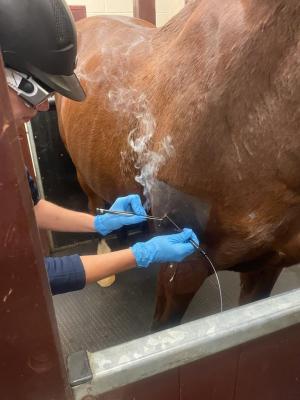Equine Therapy for Children: Psychological and Behavioral Assistance Discussed
Equine Therapy for Children: Psychological and Behavioral Assistance Discussed
Blog Article
Just How Laser Therapy in Equine Treatment Is Revolutionizing Vet Treatment for Equines
Laser treatment has actually arised as a transformative technique in equine vet treatment, supplying a non-invasive solution that speeds up healing and enhances overall health. The portability and adaptability of laser treatment devices further underscore their expanding necessity amongst vets.

Understanding Laser Treatment
Understanding laser therapy is important for appreciating its role in equine therapy. Laser therapy, also referred to as photobiomodulation, entails the application of certain wavelengths of light to tissues, which can lead to various biological results. This restorative modality utilizes the power of light energy to penetrate the skin and underlying tissues, boosting cellular procedures and improving cells repair service.
The technology behind laser treatment is based in the principle of photochemistry, where photons are soaked up by chromophores within cells, resulting in boosted ATP manufacturing and inflection of responsive oxygen varieties. This, consequently, promotes mobile expansion, reduces swelling, and accelerates recovery. Veterinary professionals use different sorts of lasers, including low-level lasers (LLLT) and high-power Class IV lasers, depending on the certain therapeutic goals and the nature of the equine problem being dealt with.
Various laser wavelengths and power settings are meticulously selected to target different cells midsts and achieve preferred clinical results. Safety and security protocols are extremely important, as inappropriate use can lead to thermal damages or suboptimal restorative results. Thus, a detailed understanding of laser therapy's mechanisms and applications is crucial for its efficient application in equine vet practice.
Benefits for Horse Health
The myriad benefits of laser treatment for equine wellness encompass enhanced healing, pain reduction, and enhanced mobility. This sophisticated therapy method leverages details wavelengths of light to permeate cells, stimulating cellular function and advertising quick cells repair. The non-invasive nature of laser treatment guarantees very little tension and pain for the steed, facilitating a smoother healing procedure.

By decreasing swelling and pain, and enhancing tissue fixing, laser treatment helps in recovering joint feature and muscular tissue versatility. Hence, laser therapy stands as a transformative device in modern equine vet care.
Usual Conditions Treated
Laser therapy has actually arised as a versatile treatment alternative for a variety of typical equine problems. Amongst these, musculoskeletal injuries are specifically amenable to laser therapy. Soft cells injuries, such as tendonitis and tendon strains, take advantage of the anti-inflammatory and analgesic results of laser treatments, which increase recovery and reduce pain. In addition, laser therapy works for problems like osteoarthritis, where it assists mitigate joint inflammation and promote tissue repair service.
Wound monitoring is an additional area where laser therapy has shown considerable pledge. Persistent wounds or slow-healing ulcers can be particularly tough in equines, yet laser treatment improves cellular regrowth and enhances blood circulation, thus quickening the recovery procedure. In addition, laser treatments have actually been effectively utilized in handling hoof conditions such as laminitis and abscesses, minimizing pain and advertising quicker healing.
Equine athletes often experience performance-related concerns like muscular tissue discomfort and anxiety fractures. Laser therapy help in minimizing muscle mass exhaustion and quickens the healing of micro-injuries, thus ensuring that steeds return to come to a head efficiency faster. By addressing these varied conditions, laser treatment is transforming the landscape of vet care, providing a non-invasive, efficient option to conventional therapies.
Technology Behind Laser Treatment

Laser tools used in veterinary medication usually utilize low-level laser therapy (LLLT) or chilly laser therapy. Unlike high-powered surgical lasers, these gadgets run at reduced energy levels, enhancing restorative advantages while reducing thermal damage. The energy from the laser light boosts adenosine triphosphate (ATP) manufacturing, improves mobile metabolism, and increases cells repair processes.
Modern laser therapy tools for equine therapy is created with adjustable settings to cater to the certain needs of different cells and conditions. Furthermore, improvements in laser technology have led to the growth of mobile, handheld devices, making it less complicated for vets to provide therapy in a variety of setups, from centers to stables.
Success Stories and Study
Showcasing the substantial benefits of laser treatment, countless success tales and case researches brighten its transformative impact on equine wellness. One such situation involves a pedigreed racehorse suffering from persistent tendonitis. Conventional therapies generated minimal enhancement, but after incorporating laser treatment into the program, the horse showed significant decreases in inflammation and discomfort within weeks, ultimately going back to competitive auto racing.
Another compelling example includes a dressage steed diagnosed with serious pain in the back, restricting its performance. A vet team employed low-level laser treatment (LLLT) to target the inflamed areas, leading to significant renovation in adaptability and a noteworthy reduction in discomfort. Over a number of sessions, the equine reclaimed its peak kind, showcasing the efficacy of laser therapy in dealing with musculoskeletal problems.
Furthermore, a study carried out at a leading equine facility taken a look at 50 horses with numerous soft cells injuries treated with laser therapy. The results were striking: 85% of the equines demonstrated accelerated healing times and improved movement. These situations emphasize the versatility and effectiveness of laser therapy in equine medication, offering a non-invasive, scientifically-backed approach to boosting recuperation and efficiency in steeds.
Conclusion
Laser treatment is changing equine vet treatment by offering a home non-invasive treatment that accelerates recovery, lowers swelling, and alleviates discomfort. With its performance in dealing with a series of conditions, from bone and joint injuries to persistent ailments like osteoarthritis, this modern technology considerably improves equine health and mobility. The transportability and versatility of laser treatment even more emphasize its transformative effect on vet techniques, strengthening its role as a vital device in contemporary equine healthcare.
Report this page